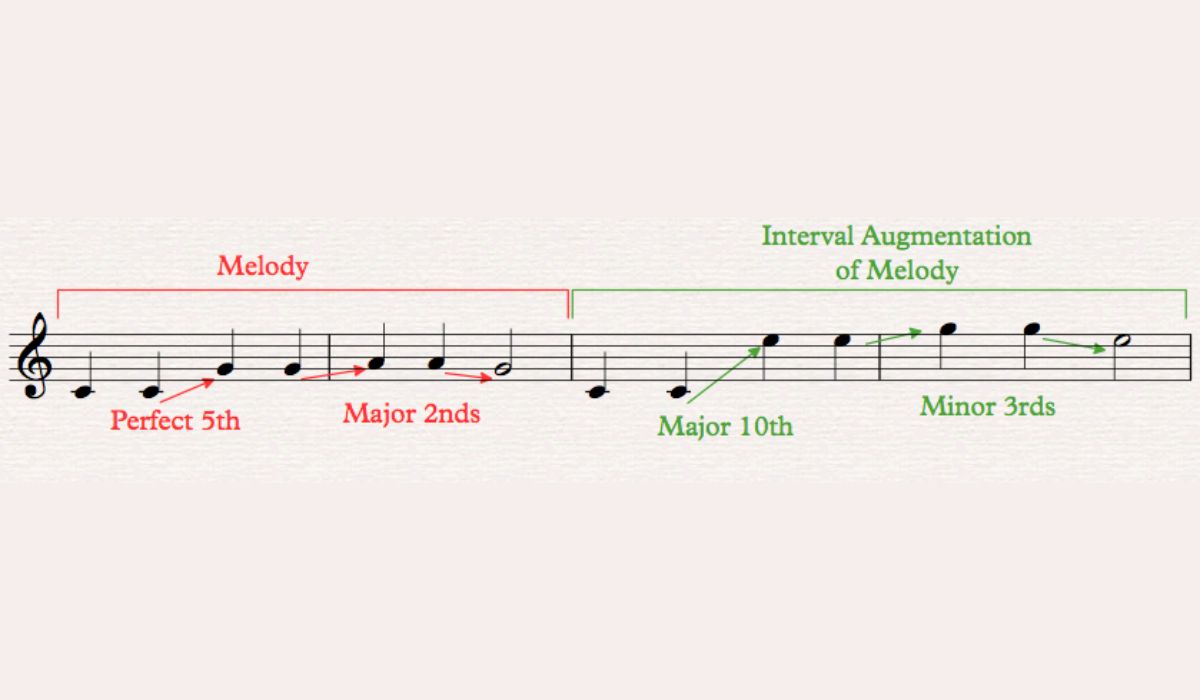Home>Production & Technology>Music Theory>Music Theory How To Amaze The Ears


Music Theory
Music Theory How To Amaze The Ears
Modified: January 30, 2024
Learn how to use music theory to amaze your ears and elevate your musical skills. Explore key concepts and techniques for mastering music theory.
(Many of the links in this article redirect to a specific reviewed product. Your purchase of these products through affiliate links helps to generate commission for AudioLover.com, at no extra cost. Learn more)
Table of Contents
- Introduction
- Understanding the Basics of Music Theory
- Building Blocks of Melody and Harmony
- Exploring Scales and Chords
- Analyzing the Components of a Song
- Creating Captivating Melodies
- Unleashing the Power of Rhythm
- Using Dynamics and Phrasing to Enhance Musicality
- Applying Advanced Music Theory Techniques
- Conclusion
Introduction
Welcome to the incredible world of music theory! If you have ever listened to a mesmerizing melody or felt the power of a harmonious chord progression, then you have experienced the magic of music theory. This fascinating discipline allows us to understand and analyze the inner workings of music, unraveling the secrets behind what makes a piece of music truly captivating.
Whether you are a musician, songwriter, composer, or simply an enthusiast looking to deepen your appreciation for music, delving into music theory will open up new realms of understanding and creativity. By gaining a solid foundation in the principles and concepts of music theory, you will be able to amaze your own ears and those of others.
In this article series, we will take a journey through the various elements of music theory, exploring everything from scales and chords to rhythm and phrasing. We will uncover the building blocks of melody and harmony, learn how to analyze the components of a song, and discover techniques to create captivating melodies. Furthermore, we will dive into the world of advanced music theory, where complex concepts like modal interchange and chromatic modulation will be demystified.
By the end of this series, you will have a solid understanding of music theory and be equipped to apply it in your own musical endeavors. Whether you aspire to write breathtaking compositions, play impressive solos, or simply have a deeper appreciation for the music you love, this journey into music theory will help you achieve those goals.
So, grab your instrument, put on your favorite piece of music, and get ready to embark on an exciting exploration of music theory. Get ready to amaze your ears and unlock the secrets of harmonious beauty!
Understanding the Basics of Music Theory
Before diving into the complexities of music theory, it is essential to understand the fundamental concepts that form its backbone. At its core, music theory is a system of understanding and organizing musical elements, such as melody, harmony, rhythm, and form.
One of the first concepts to grasp is the musical staff, which consists of five horizontal lines with four spaces in between. Notes are placed on or between these lines to represent specific pitches. Each line and space correspond to a different letter, which represents a specific musical note. The arrangement of these notes on the staff creates a melody.
Another crucial aspect of music theory is understanding rhythm. Rhythm is the pattern of sounds and silences in a piece of music. It is represented by different note durations, such as whole notes, half notes, quarter notes, and eighth notes. Learning how to read and interpret rhythm notation is essential to playing and understanding music.
Harmony is another fundamental element of music theory. It deals with how different notes and chords work together to create a sense of harmony and progression. Chords are groups of three or more notes played simultaneously and provide a foundation for other musical elements. By studying chords, their inversions, and their relationships, we can begin to understand the harmony behind music.
In addition to melody, rhythm, and harmony, music theory also encompasses the study of scales and key signatures. Scales are sequences of musical notes played in ascending or descending order. They provide the framework for creating melodies and harmonies by determining which notes are consonant or dissonant in a given key. Key signatures, on the other hand, help identify the tonal center of a piece of music and determine which notes are sharp or flat.
Understanding the basics of music theory lays a strong foundation for further exploration. By grasping concepts such as notation, rhythm, harmony, scales, and key signatures, you will be equipped to analyze and create music with greater depth and understanding. So, let’s continue our journey into music theory and uncover the building blocks of melody and harmony.
Building Blocks of Melody and Harmony
When it comes to music, melody and harmony are essential components that give depth and emotional impact to a composition. Understanding the building blocks of melody and harmony is crucial for any musician or composer.
Let’s start with melody. Melody is the memorable and recognizable sequence of musical notes that form the main theme or idea of a piece. It is the part of the music that you can hum or sing along to. Melodies are built using scales, which are sequences of notes played in a specific order. The most commonly used scale in Western music is the major scale, but there are many other scales that evoke different emotions and moods.
Harmony, on the other hand, refers to the combination of simultaneous musical notes to create chords. Chords provide stability and support to the melody. They are formed by stacking specific notes from a scale on top of each other. The most basic chord is a triad, which consists of three notes played together. Understanding chord progressions and how different chords interact with each other is crucial to creating harmonically rich music.
When it comes to melody and harmony, there are certain guidelines and principles that musicians follow to create cohesive and engaging compositions. One of these is the concept of consonance and dissonance. Consonant sounds are pleasing and stable to the ear, while dissonant sounds create tension and need resolution. Balancing moments of consonance and dissonance is essential for creating emotional impact and interest in a piece of music.
Another important aspect of building melody and harmony is the use of motifs and phrases. A motif is a short musical idea that is repeated or developed throughout a composition. By using motifs, composers can create unity and coherence in their music. Phrases, on the other hand, are complete musical thoughts or sentences. They have a beginning, middle, and end, and are often repeated or varied to create structure in a piece.
By understanding the building blocks of melody and harmony – scales, chords, consonance, dissonance, motifs, and phrases – you will be able to create captivating and emotionally rich music. So, let’s delve deeper into the intricacies of scales and chords, and explore their role in shaping melodies and harmonies.
Exploring Scales and Chords
Scales and chords are the foundation of melody and harmony in music. They provide the essential framework for creating and understanding musical compositions. Let’s dive into the world of scales and chords and explore their fascinating role in music theory.
A scale is a sequence of musical notes played in a specific order. Scales have a tonic note, which is often referred to as the “root” note, and serve as the basis for melodies and harmonies. The most commonly used scale in Western music is the major scale, consisting of seven notes. Each scale degree has a unique role and relationship to the tonic, creating different emotional qualities and melodies.
Furthermore, scales can be major or minor, depending on the specific pattern of whole and half steps between the notes. The major scale has a bright and uplifting sound, while the minor scale has a more melancholic and introspective feel. By exploring different scales and their unique characteristics, you can add depth and emotion to your compositions.
Chords, on the other hand, are groups of three or more notes played simultaneously. They provide the harmonic backbone of a composition, complementing the melody. Chords are built by selecting specific notes from a scale and stacking them on top of each other. The most basic chord is the triad, which consists of the root, third, and fifth notes of a scale.
There are different types of chords, including major chords, minor chords, diminished chords, augmented chords, and more. Each chord type has its own distinct sound and emotional quality. By understanding how chords are constructed and how they function within a key, you can create interesting and engaging harmonies in your compositions.
One important aspect of chord progression is understanding the concept of chord function. In a key, certain chords act as points of stability or tension. The tonic chord, for example, provides a sense of resolution, while the dominant chord creates tension and a desire for resolution. By using different chord progressions, you can create a sense of movement and emotional impact in your music.
Exploring scales and chords opens up a world of possibilities in music composition. By understanding the different scales and their emotional qualities, as well as the construction and function of chords, you can create melodies and harmonies that captivate the ears and evoke powerful emotions. So, let’s continue our exploration of music theory and take a closer look at the components of a song.
Analyzing the Components of a Song
When listening to a song, it’s easy to get carried away by its melodies and harmonies. However, taking the time to analyze the components of a song can provide valuable insights into its structure and help you appreciate the artistry behind it. Let’s delve into the different components of a song and explore how they contribute to its overall composition.
The first component to analyze is the song structure. Most songs follow a common structure that consists of verses, choruses, bridges, and sometimes pre-choruses and outros. Understanding the arrangement of these sections helps identify patterns and creates a sense of familiarity for the listener. By examining the song’s structure, you can uncover how the different sections are organized and how they contribute to the overall message and impact of the song.
Melody is another essential component of a song. It is the memorable and singable element that carries the tune. Analyzing the melodic contour and phrasing can reveal the emotional journey the song takes the listener on. Pay attention to how the melody interacts with the lyrics and how it flows over the chords. By understanding the intricacies of the melody, you can gain a deeper appreciation for the song’s craftsmanship.
Harmony plays a crucial role in supporting the melody and creating a sense of depth and richness. Analyzing the chord progressions, modulations, and harmonic transitions within a song can unveil how the chords establish tension and release. Look for moments of resolution and how different chords contribute to the overall emotional impact. By studying the harmony of a song, you can gain insight into the compositional choices made by the songwriter.
The lyrics of a song are the storyteller’s tools, conveying emotions, experiences, and messages. Analyzing the lyrics can provide insight into the songwriter’s intentions, themes, and poetic choices. Pay attention to the storytelling techniques used, such as metaphors, imagery, and wordplay. By studying the lyrics, you can connect with the songwriter’s emotions and understand the deeper layers of the song’s meaning.
Rhythm and groove give life to a song, creating its energy and movement. Analyzing the rhythmic patterns, syncopation, and the interaction between different instruments and percussion elements can unveil the song’s dynamic feel. Pay attention to the variations in rhythm and the use of accents and rests. By studying the rhythm, you can appreciate the intricacies of the groove and how it adds to the overall musicality of the song.
By analyzing the various components of a song – structure, melody, harmony, lyrics, and rhythm – you can gain a deeper understanding of its composition. This analysis allows you to appreciate the craftsmanship, creativity, and thoughtfulness that go into creating a powerful and meaningful musical piece. So, let’s continue our exploration of music theory and explore the art of creating captivating melodies.
Creating Captivating Melodies
One of the most captivating aspects of a song is its melody. A well-crafted melody has the power to stick in our minds and evoke a range of emotions. Whether you’re a songwriter or an instrumentalist, understanding the principles and techniques behind creating captivating melodies can help elevate your music to the next level.
The first step in creating a captivating melody is to have a strong foundation in music theory, particularly in scales and intervals. By understanding the relationship between notes and the structure of scales, you can navigate the musical landscape with ease. Experimenting with different scales, such as the major scale, minor scale, and modes, can help you discover unique and interesting melodic possibilities.
Variation is key when crafting a memorable melody. Utilize techniques such as repetition, sequence, and variation to create melodic motifs that catch the listener’s ear. Repetition brings familiarity and unity to a melody, while variation adds interest and keeps the audience engaged. By combining both approaches, you can create a balance between predictability and surprise in your melodies.
Another technique to consider is the use of contour. Contour refers to the shape and direction of a melody. Experiment with ascending, descending, and wave-like shapes to convey different emotions and moods. A rising melody can create a sense of excitement or anticipation, while a descending melody may evoke a feeling of calm or resolution.
Emotional expression is a crucial aspect of captivating melodies. Use dynamics, such as subtle changes in volume, to add depth and intensity to your melodic lines. Pay attention to the phrasing and articulation of your melodies to convey the desired emotions. Experiment with techniques like legato (smooth and connected) and staccato (short and detached) to create different textures and add emotional nuances.
Incorporating rhythmic elements into your melodies can also enhance their captivation. Experiment with syncopation, where the emphasis is placed on offbeats, or use rhythmic patterns to create a rhythmic hook that sticks in the listener’s mind. Incorporate rests strategically to create moments of tension and release.
Lastly, don’t be afraid to think outside the box and experiment with unconventional melodic structures. Break free from standard song forms and explore unconventional intervals, chromaticism, and modal interchange. Push the boundaries of melodic conventions to create unique and intriguing melodies that leave a lasting impression.
By understanding the principles of music theory, utilizing variation and contour, expressing emotions through dynamics and phrasing, incorporating rhythmic elements, and experimenting with unconventional structures, you can create captivating melodies that enchant and resonate with your audience. So, let your imagination soar and infuse your music with melodies that captivate the hearts and minds of all who listen.
Unleashing the Power of Rhythm
Rhythm is the heartbeat of music. It is the driving force that gives a composition its energy, groove, and movement. Understanding and harnessing the power of rhythm can take your music to new heights. Whether you’re a drummer, guitarist, pianist, or vocalist, incorporating rhythmic elements into your playing can greatly enhance the impact and dynamics of your music.
One of the most important aspects of rhythm is the concept of timing. A strong sense of timing allows musicians to play in sync with each other and creates a cohesive and tight performance. Practicing with a metronome or playing along with recorded music can help develop your timing skills and strengthen your rhythmic precision.
Syncopation is another element that adds excitement and interest to music. Syncopation occurs when accent or emphasis is placed on offbeats or unexpected parts of the measure. It creates tension and keeps the listener engaged. Experimenting with syncopated rhythms can give your music a unique and captivating feel.
Phrasing is another powerful tool to explore in rhythm. Just as in speech, musical phrases allow for natural breathing and expression within a melody or groove. By varying the lengths and patterns of your phrases, you can create a sense of tension, release, and musical conversation. Pay attention to the spaces between the notes and the subtle pauses that add depth and contour to your rhythmic patterns.
Polyrhythms, or the simultaneous combination of different rhythmic patterns, can add complexity and texture to your music. By layering multiple rhythms together, you create a rich and intricate rhythmic tapestry. Experiment with different subdivisions and explore how different rhythms interact and complement each other.
Dynamic control is essential in rhythm. Understanding how to use varying levels of volume and intensity can greatly enhance the musicality of your rhythmic performance. Experiment with accents, ghost notes, and crescendos to add depth and expression to your rhythm playing.
Rhythm is not just limited to instruments – it is also a vital component of vocal performances. By understanding the rhythmic nuances of the lyrics and melodies, singers can bring out the natural rhythmic patterns of the music. Pay attention to the rhythmic phrasing of the lyrics and how they interplay with the instrumental accompaniment.
Lastly, don’t be afraid to break free from conventional rhythmic patterns and explore unconventional meters and time signatures. Experiment with odd meters like 5/4, 7/8, or even polyrhythmic patterns to challenge yourself and add a unique flair to your music.
Unleashing the power of rhythm can transform your music, adding depth, energy, and excitement. By refining your timing, incorporating syncopation, utilizing phrasing, exploring polyrhythms, mastering dynamic control, and experimenting with unconventional rhythms, you can truly unleash the power and magic of rhythm in your music. So, let the rhythm guide you and infuse your compositions with irresistible groove and movement.
Using Dynamics and Phrasing to Enhance Musicality
When it comes to musical performances, dynamics and phrasing play a crucial role in expressing emotions, creating contrast, and elevating the overall musicality. By mastering the art of dynamics and phrasing, you can bring your music to life and captivate your audience. Let’s explore how these elements can enhance your musicality.
Dynamics refer to the variations in volume, intensity, and expression within a musical performance. By understanding and incorporating different dynamic levels, you can create a sense of tension, release, and emotion in your music. Experiment with playing softly (piano) and gradually increasing the volume (crescendo) to create anticipation and intensity. Contrastingly, playing loudly (forte) and suddenly reducing the volume (decrescendo) can create moments of surprise and highlight delicate nuances.
One way to enhance musicality is by utilizing dynamic markings such as pianissimo (very soft), mezzo piano (moderately soft), mezzo forte (moderately loud), and fortissimo (very loud). By following these markings, you can add depth and expression to your performance. Additionally, pay attention to the subtle changes in dynamics within phrases and sections to shape the musical narrative.
Phrasing involves the grouping of musical notes into meaningful musical sentences or ideas. Just as in spoken language, phrasing in music provides structure, coherence, and expression. By emphasizing certain notes or words within a phrase and using subtle pauses and breaths, you can create a natural and flowing musical conversation. Experiment with legato (smoothly connected) and staccato (short and detached) techniques to add variety and shape to your phrasing.
Understanding the relationship between phrasing and breathing is especially important for vocalists and wind instrument players. Proper breath support and control allow for the seamless delivery of phrases and enhance the communication of emotions through the music. Explore different breath placements within phrases to find the most effective and expressive delivery.
Variation in phrasing can also add interest and musicality to your performance. Experiment with stretching or compressing certain phrases, adding ornaments, or improvising within the structure of a piece. These creative variations can bring a personal touch and make the music truly your own.
Using dynamics and phrasing in harmony can truly elevate your musicality. Pay attention to how changes in dynamics can complement and enhance the shape and flow of your phrasing. By carefully crafting your dynamics and phrasing choices, you can create a powerful and captivating musical story.
Remember, dynamics and phrasing are not solely technical aspects of music, but rather expressive tools that allow you to convey your emotions and engage your audience. By mastering the art of dynamics and phrasing, you can enhance the musicality of your performances, breathe life into your compositions, and connect with your listeners on a deeper level. So, let your music speak with dynamic range and expressive phrasing, and unleash the full potential of your musicality.
Applying Advanced Music Theory Techniques
Once you have a solid foundation in music theory, exploring advanced techniques can elevate your compositions and performances to new heights. These techniques dive deeper into the intricacies of harmony, melody, and composition, allowing for more complex and nuanced musical expressions. Let’s explore some advanced music theory techniques and how they can enhance your musicality.
Modal interchange is a powerful technique that involves borrowing chords or tones from a different musical mode than the one the song is primarily in. By incorporating chords or notes from parallel or related modes, you can add color and create unexpected yet harmonically intriguing moments. Modal interchange allows you to explore new tonalities and inject a fresh dynamic into your compositions.
Chromatic modulation is another advanced technique that takes you from one key to another, seamlessly transitioning between tonalities. By smoothly introducing chromatic chords, you can create a subtle or dramatic shift in the mood and feel of the music. Chromatic modulation adds complexity and interest, keeping listeners engaged and providing a sense of musical journey.
Extended chords are chords that incorporate additional tones beyond the basic triads. Examples include seventh chords, ninth chords, eleventh chords, and beyond. By using extended chords, you can create rich and lush harmonies that add depth and sophistication to your compositions. These chords can evoke different emotions and create unique tonal colors.
Counterpoint is an advanced technique that involves the simultaneous combination of multiple independent melodic lines. By intertwining different melodies that complement and interact with each other, you create intricate and harmonically rich textures. Counterpoint requires careful attention to voice leading and the relationship between the melodic lines, resulting in a complex and fascinating musical tapestry.
Polytonality is the use of two or more different tonalities or key centers simultaneously. By incorporating multiple tonalities, you can create tension, dissonance, and unique harmonic flavors. Polytonality can add complexity and a sense of avant-garde or experimental sound to your compositions, pushing the boundaries of traditional harmony.
Modes and scales beyond the major and minor scales can offer additional possibilities for musical exploration. Modes such as the Dorian, Phrygian, and Lydian modes present distinct tonalities and flavors. Experimenting with these modes can lead to fresh and unique melodic and harmonic ideas.
Advanced rhythm techniques, such as polymeter, odd time signatures, and metric modulation, can add complexity and rhythmic interest to your compositions. By exploring rhythmic variations and challenging rhythmic patterns, you can create captivating and dynamic rhythmic landscapes.
These advanced music theory techniques open up a world of creative possibilities. By incorporating modal interchange, chromatic modulation, extended chords, counterpoint, polytonality, exploring different modes, and experimenting with advanced rhythm techniques, you can push the boundaries of your music and infuse it with depth, complexity, and innovation.
Remember, advanced techniques should be used judiciously and purposefully. They are meant to enhance your musical expression and serve the overall composition or performance. By incorporating these techniques with intention and creativity, you can take your music to new and exciting places.
Conclusion
Congratulations on completing this journey into the world of music theory! Throughout this article series, we have explored the fundamental principles and advanced techniques that make up the essence of music theory. We have discovered the building blocks of melody and harmony, delved into scales and chords, analyzed the components of a song, explored the art of creating captivating melodies, and unleashed the power of rhythm. We have also discussed the importance of dynamics and phrasing in enhancing musicality and touched upon applying advanced music theory techniques.
By gaining a deep understanding of music theory, you have equipped yourself with the tools to amaze the ears and elevate your musical creations. You now have the foundation to navigate the complexities of melody, harmony, rhythm, and form. Whether you are a musician, songwriter, composer, or simply an enthusiast, the knowledge and techniques covered in this series will expand your musical horizons and deepen your appreciation for the art of music.
Remember, music theory is not just a set of rules to follow; it is a language through which you can express your emotions, tell stories, and connect with others. As you continue on your musical journey, don’t be afraid to experiment, take risks, and explore your own unique musical voice. Embrace creativity and let your passion guide you as you continue to grow and evolve as a musician.
Music theory is a never-ending exploration. There is always more to learn and discover. So, continue to expand your knowledge and refine your skills. Keep listening to a wide range of musical genres and styles, drawing inspiration from different sources. Immerse yourself in the world of music, both as a performer and a listener.
Thank you for joining us on this musical adventure. We hope that this article series has inspired and empowered you to take your music to new heights. So go forth and continue to amaze the ears with your creativity, passion, and newfound understanding of music theory. Happy composing, performing, and exploring the vast and beautiful world of music!











